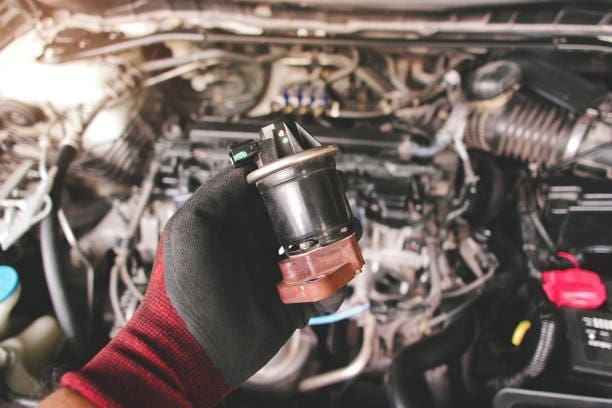EGR Filter System for Ford, renowned for its robust performance and reliability, powers many Ford Super Duty trucks. Integral to maintaining the engine’s efficiency and meeting emissions regulations is the Exhaust Gas Recirculation (EGR) filter system. In this comprehensive guide, we’ll explore the function and importance of the EGR filter system in the 6.7 Powerstroke, discuss common issues, and provide maintenance tips to keep your engine running smoothly.
What is the EGR System?
Table of Contents
Toggle
The EGR system is an essential component of modern diesel engines, designed to reduce nitrogen oxide (NOx) emissions. Here’s how it works:
EGR System Overview
The EGR system recirculates a portion of the engine’s exhaust gases back into the intake manifold. By doing so, it lowers the combustion temperature within the engine. Lower combustion temperatures result in reduced formation of NOx gases, which are harmful pollutants contributing to smog and acid rain.
Components of the EGR System
- EGR Valve: Controls the flow of exhaust gases into the intake manifold. It can be operated electronically or pneumatically.
- EGR Cooler: Cools the exhaust gases before they are reintroduced into the intake manifold. This is crucial for reducing engine temperatures and improving efficiency.
- EGR Filter: Positioned within the EGR system to capture and remove particulate matter from the exhaust gases before they enter the intake manifold.
Importance of the EGR Filter System
The EGR filter system is vital for several reasons:
Emission Control
The primary purpose of the EGR filter system is to help meet stringent emissions regulations. By reducing NOx emissions, the system plays a crucial role in ensuring that the 6.7 Powerstroke complies with environmental standards.
Engine Efficiency
A properly functioning EGR filter system improves engine efficiency. By reducing the amount of heat generated during combustion and minimizing the buildup of carbon deposits, the system helps maintain optimal engine performance and fuel efficiency.
Longevity and Reliability
Maintaining a clean EGR filter is essential for the longevity of your engine. A clogged or malfunctioning EGR filter can lead to increased exhaust backpressure, reduced engine performance, and potential damage to other engine components.
Common Issues with the EGR Filter System
While the EGR filter system is designed to enhance engine performance and emissions control, it can encounter several issues over time.
Clogging and Carbon Build-Up
One of the most common problems with the EGR filter is clogging due to carbon build-up. Diesel engines produce soot and other particulates that can accumulate in the EGR filter, restricting airflow and reducing efficiency. This can lead to increased exhaust backpressure and engine performance issues.
EGR Valve Failure
The EGR valve is a critical component of the EGR system. If it fails, it can cause the system to malfunction, leading to poor engine performance, increased emissions, and potential engine damage. Symptoms of a failing EGR valve include rough idling, reduced acceleration, and increased fuel consumption.
Leaks in the EGR Cooler
The EGR cooler is designed to reduce the temperature of the exhaust gases before they enter the intake manifold. If the cooler develops leaks or fails, it can lead to overheating of the engine and reduced efficiency. Leaks may also cause coolant to mix with exhaust gases, leading to potential engine damage.
Signs of EGR Filter System Issues
Recognizing the signs of EGR filter system problems early can help prevent more serious issues. Here are some common symptoms:
Check Engine Light
A common indicator of EGR system issues is the illumination of the check engine light. The vehicle’s onboard diagnostic system will detect any malfunctions within the EGR system and trigger the warning light.
Poor Engine Performance
If you notice a decrease in engine performance, such as reduced acceleration, poor fuel economy, or rough idling, it could be a sign of a clogged or malfunctioning EGR filter.
Increased Exhaust Smoke
Excessive exhaust smoke, particularly black or white smoke, can indicate problems with the EGR system. Black smoke may suggest incomplete combustion or a clogged filter, while white smoke could be a sign of coolant entering the exhaust system.
Maintenance and Care for the EGR Filter System
Proper maintenance of the EGR filter system is crucial for ensuring optimal performance and longevity of your Ford 6.7 Powerstroke engine.
Regular Inspections
Regular inspections of the EGR system can help identify potential issues before they become serious problems. Check the EGR valve, cooler, and filter for signs of wear, damage, or clogging. Schedule routine maintenance with a qualified technician to ensure that the system is functioning correctly.
Cleaning the EGR Filter
Cleaning the EGR filter periodically can help prevent clogging and maintain engine efficiency. Depending on driving conditions and usage, the filter may need to be cleaned or replaced every 30,000 to 60,000 miles. Always refer to the manufacturer’s recommendations for specific maintenance intervals.
Replacing Faulty Components
If any components of the EGR system are found to be faulty, such as the EGR valve or cooler, they should be replaced promptly. Using high-quality replacement parts and having them installed by a professional can help ensure the continued reliability of the system.
Keeping the Engine Clean
Regularly cleaning the engine and intake system can help prevent the buildup of carbon and other contaminants. This includes cleaning the intake manifold, turbocharger, and intercooler, as well as using high-quality fuel to minimize soot production.
Upgrading and Modifying the EGR System
Some vehicle owners choose to upgrade or modify their EGR systems for various reasons, including performance enhancement or to address specific issues.
EGR Delete Kits
EGR delete kits are available for those who wish to remove the EGR system entirely. These kits often include block-off plates and reprogramming services to bypass the EGR system. While EGR deletes can improve performance and reduce maintenance costs, they can also lead to increased emissions and may violate local emissions regulations.
Performance Upgrades
For those seeking to enhance engine performance without removing the EGR system, performance upgrades such as high-flow EGR valves and coolers can be considered. These upgrades can improve efficiency and reliability while maintaining compliance with emissions standards.
Legal and Environmental Considerations
When modifying or upgrading the EGR system, it’s essential to consider the legal and environmental implications.
Emissions Regulations
Many regions have strict emissions regulations that require vehicles to meet specific standards. Removing or modifying the EGR system can result in non-compliance with these regulations, leading to fines, penalties, or difficulties in passing emissions tests.
Environmental Impact
Disabling the EGR system can increase the emission of NOx and other pollutants, contributing to environmental pollution and climate change. It’s important to weigh the performance benefits against the potential environmental impact and legal consequences.
Professional Service and Repair

For the best results and to ensure compliance with regulations, it’s recommended to seek professional service for the EGR filter system. Certified technicians have the expertise and equipment needed to diagnose, repair, and maintain the system properly.
Choosing a Service Provider
- Experience and Expertise: Look for service providers with experience working on Ford 6.7 Powerstroke engines and a strong track record of EGR system repairs and maintenance.
- Certification and Equipment: Ensure that the provider uses certified parts and advanced diagnostic equipment to ensure accurate repairs and maintenance.
- Customer Reviews: Check customer reviews and testimonials to gauge the quality of service and customer satisfaction.
- Warranty and Support: Choose a provider that offers warranties on their work and provides ongoing support for any issues that may arise.
Conclusion
The EGR filter system is a crucial component of the Ford 6.7 Powerstroke engine, playing a vital role in reducing emissions, improving engine efficiency, and ensuring compliance with environmental regulations. Understanding the function of the EGR system, recognizing common issues, and performing regular maintenance can help keep your engine running smoothly and efficiently.
Whether you’re addressing specific issues with your EGR system or considering upgrades, it’s essential to consider the legal and environmental implications of any modifications. By staying informed and working with qualified professionals, you can ensure the continued performance and reliability of your Ford 6.7 Powerstroke engine while meeting emissions standards and protecting the environment.



